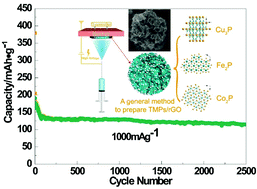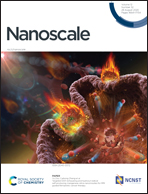Bicontinuous transition metal phosphides/rGO binder-free electrodes: generalized synthesis and excellent cycling stability for sodium storage†
Abstract
Transition metal phosphides (TMPs) have received considerable attention owing to their great potential in energy conversion and storage technologies. Elaborate design and synthesis of various TMPs with abundant structures in order to meet the requirements of various applications is one of the major goals and challenges of sustainable chemistry. In this work, an electrostatic spray deposition (ESD) approach has been developed and has been demonstrated to be a general strategy to fabricate TMPs for the first time. Various bicontinuous TMPs/carbon nanocomposites can be constructed by this approach. This novel architecture, when applied in energy storage systems, can provide an efficient electron/ion mixed-conducting network, thereby inducing fast electron/ion transfer kinetics and enhancing the structural stability upon long term cycling. As proof of concept application, 3D porous Cu3P/rGO nanocomposites as modeling anodes for Na-ion storage show excellent cycling performance and remarkable rate capacities. The sodium storage mechanism is proposed to be a reversible conversion reaction. The microstructural evolution of the electrodes upon cycling correlates well with the capacity variation. The facile and versatile ESD technique is quite universal and can be further extended to various TMPs. This opens exciting opportunities for the incorporation of TMPs in a variety of new applications.



 Please wait while we load your content...
Please wait while we load your content...